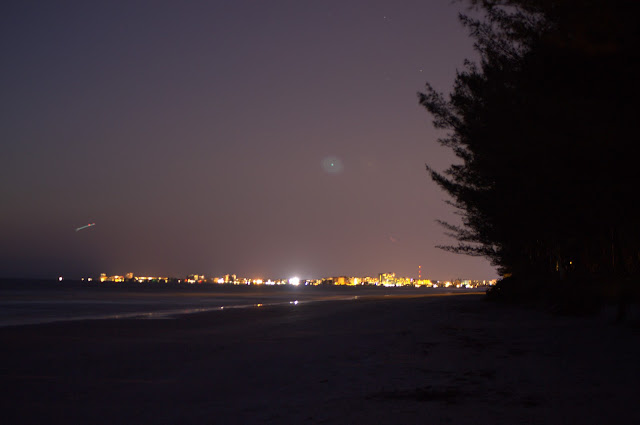After I saw the last of PANSTARRS heading away from this part of the universe and getting a definitive shot of it (5-8, 5-9 posts) I stuck around at my position at the boardwalk at Sunset Beach for a while. I wanted to take some more pictures and now was a good time to do some experimentation. Most of these below are failed attempts at something. Sadly my skills are lacking with the exposure, aperture, shutter speed, ISO settings and all that but I plug away like the brave Nikonian soldier I am.
I post the following not to impress, Lord, not with these!, but to show you that for every good picture there may be 20, 30, or more that you throw away into the "Trash" icon. The beauty of digital photography is that you can take literally hundreds of snapshots with out any cost. This was not possible back in the film days so sometimes progress is a very good bargain. I used a Poloroid mostly back growing up - I liked the instant nature of the thing, but every picture cost a bundle. Film was expensive for those cameras - you paid dearly for being impatient. Now you take the digital and snap to your heart's content or until your card is full or your battery loses juice.
There are 2 boardwalks in close proximity at this part of the beach. This is a pic looking South toward the Don Cesare hotel. Shutter speed was quite fast as there is very little light.
Same exposure but I moved the camera bit to the right to get a tall red beacon light down the coast. These are none too crisp and aren't very good, but one should play with the settings as much as possible. I have tinkered with the idea of taking a small notepad to jot down settings for future reference. I have also tinkered with the notion that taking a notepad to jot down settings is waaaaaay too pro for me.
I decided to increase exposure to a few seconds longer to allow more light to filter in. The parking lot streetlight provided a good source. This picture had promise, and had I wanted to do some more post-editing it may have even been a good picture. But since I don't have any post-editing program, and quickly flit from one scene to the next this one will go unrefined.
Again, I must have made this a 10 second exposure thus creating a kind of ethereal look to the nighttime beach area. So I quickly deduced that at night you need a longer exposure to allow more light. By Jove, the kid may be getting it after all.
I must have then made it into a shorter exposure, because now we have the same view only with less light, turning it back into a night scene. I enjoyed the lights down the coast and those on the right are boats out in the Gulf.
I then trained the camera in the opposite direction looking North. Again, it's a failed attempt at something, I don't know what. First its blurry. Second, no those aren't invading spaceships, that's called lens glare. There are two types of lens: zoom where you can move in or out on a subject, and fixed, which stay in one setting and you can't make it closer or farther away. With zoom lenses because of their construction, prisms, and ability to zoom, glare is something you risk. If I had taken these with a fixed lens there wouldn't be glare. Oh, and lens are expensive so glare will just have to be part of the process.
Over to the left you might see what looks to be a line with a red light in the sky. That is a helicopter.
Continuing with the failed theme, I did a timed exposure with the chopper and the next two pics clearly reveal a true amateur at work.
It may be interesting for some to see this kind of slapdash nonsense but I can tell you these have been trashed and removed from my storage. Hell, they aren't even in focus. Now they have me swearing.
Anyway, it's part of the learning process, and hopefully they will help teach a novice to better study the art. Remember to take your camera wherever you go; life is teeming all around you. Cameras are wonderful things and can do so much, even in the hands of a hack.









Comments
Post a Comment